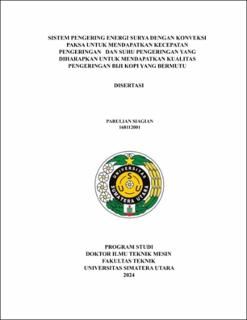Sistem Pengering Energi Surya dengan Konveksi Paksa untuk Mendapatkan Kecepatan Pengeringan dan Suhu Pengeringan yang Diharapkan untuk Mendapatkan Kualitas Pengeringan Biji Kopi yang Bermutu
Solar Energy Dryer System with Forced Convection to Obtain the Expected Drying Speed and Drying Temperature to Obtain Quality Drying of Coffee Beans

Date
2025Author
Siagian, Parulian
Advisor(s)
Napitupulu, Farel Hasiholan
Ambarita, Himsar
Metadata
Show full item recordAbstract
Drying airflow velocity has a very large role in the drying rate of agricultural commodities such as coffee. High airflow velocity is proven to increase the drying rate of coffee as seen in the decrease of water content faster than the lower airflow velocity. High drying rate is one of the factors that improve the quality and quality of coffee, but it is not yet known whether it affects the quality of the coffee seen from carbohydrates, protein, free fatty acids and water content. This study aims to see the effect of airflow velocity entering the forced solar dryer on coffee quality. The research method was carried out by indirect testing by designing solar collectors and drying boxes as many as 5 units. Testing was carried out for 3 days until the moisture content of
coffee beans was 12-13%. The treatment of dryer air velocity variations are: 1.0 m/s; 1.5 m/s; 2.0 m/s; 2.5 m/s; and 3.0 m/s with the initial mass of coffee beans is 1500 grams and 65% moisture content. The test results show from 5 dryers that in tool 1 (BD1) with an air speed of 1.0 m/s, the final mass of coffee beans = 732.249 grams, tool 2 (BD2) with an air speed of 1.5 m/s the final mass of coffee beans = 774. 70 grams, BD3 air speed 2.0 m/s final mass = 855.10 grams, device 4 (BD4) with air speed 2.50 m/s final mass of coffee beans = 745.79 and BD5 final mass of coffee beans = 786.40 grams. Final moisture content (MC) in the dryer: MC-BD1 = 12%, MCBD2 = 13.6%, MC-BD3 = 18.5%, MC-BD4 = 12.9% and MC-BD5 = 15.2%. Protein content in BD1 = 11.7%, BD2 = 12.2%, BD3 = 11.5%, BD4 = 11.6% and BD5 = 11.3%. Carbohydrate BD2 = 22.8% Free fatty acid (ALB) content BD2= 0.05%. In this study, it was found that quality coffee beans with a moisture content of 12% were produced by dryer 1 or BD1. The time needed to dry was 27 hours with a temperature of 41.10C and the efficiency of the dryer collector was 46%.
